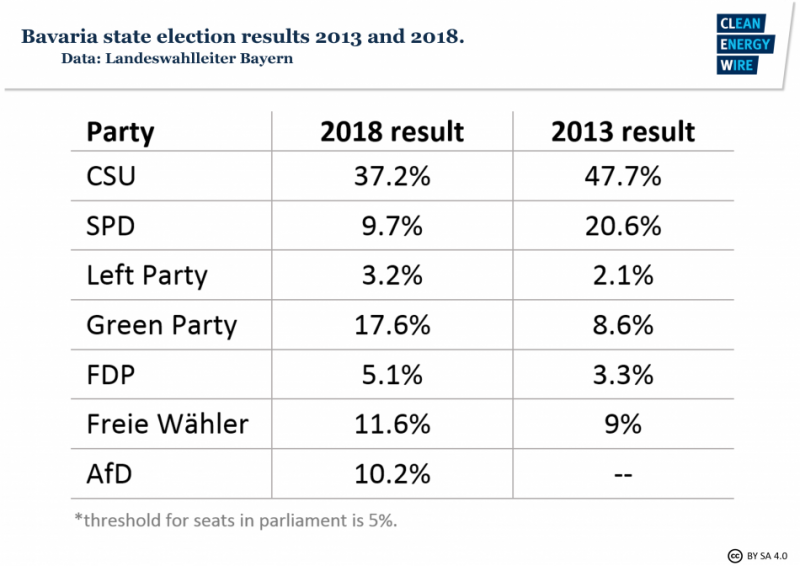Facts on the German state elections in Bavaria
[Also read the CLEW article Bavarian vote shakes Berlin coalition, leaves energy policy in limbo and the election preview Shake-up in Bavaria's election may impact German energy policy]
Bavaria
Population: 13,003,252 (January 2018)
State capital: Munich
Votes in the Bundesrat: 6 out of 69
Government:
Christian Social Union in Bavaria (CSU) and Free Voters
State premier: Markus Söder (CSU)
Minister for Economy, Regional Development and Energy: Hubert Aiwanger (Free Voters)
Minister for Environment and Consumer Protection: Thorsten Glauber (Free Voters)
Minister for Food, Agriculture and Forestry: Michaela Kaniber (CSU)
New Bavarian government coalition plans state climate protection law
Bavarian conservative parties Christian Socialist Union (CSU) and Free Voters have signed a coalition treaty for the coming five years in Germany’s southern economic power house and largest federal state. The alliance aims to make climate protection a “constitutional goal” and introduce a climate protection law which will include concrete CO₂ targets to reduce greenhouse gas emissions to under two tonnes per citizen annually by 2050. “We are setting a conscious signal for sustainable ecology. Bavaria can become greener, without the Greens,” said current state premier Markus Söder (CSU), who will likely remain head of government. Many conservatives had called for improvements and changes in this regard, and the CSU had “learned” from this, he added. The parties emphasised that they see “the most regional and decentralised energy supply possible as a great opportunity for local value creation”. Renewables expansion will be done “in agreement with” the population and municipalities, and cities will be made greener with the coalition’s “City.Climate.Nature” initiative. At the federal level, the new state government will call for more renewables capacity for Germany’s south in upcoming auctions, advocate the expansion of European emissions trading, and support federal initiatives for an internationally coordinated introduction of a CO₂ price.
State parties’ websites (in German):
CSU, SPD, Green Party, Left Party, FDP, AfD, Freie Wähler
Climate and energy targets in Bavaria
The state government’s “Bavarian Energy Programme; secure – affordable – environmentally-friendly”, decided in 2015, stipulates several energy transition targets for 2025. Primary energy consumption is to be reduced by 10 percent, compared to 2010, and renewable energy should cover 20 percent of primary energy consumption and 70 percent of power generation. The programme acknowledges that the nuclear exit and renewables expansion must not place an additional burden on the climate.
“The phase-out of nuclear energy cannot mean a return to coal as the most important source of energy. Bavaria's energy policy therefore aims to ensure that renewable energies account for as much of electricity generation as possible.” To guarantee supply security for Bavaria’s economy, “modern gas power plants and demand-oriented hydropower and biogas plants are indispensable.”




